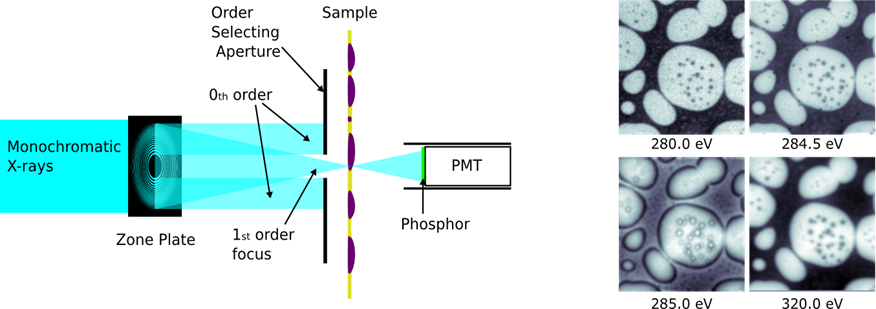XRM
X-Ray Microscopy
Characterisation Installation 4
STXM is a non-invasive x-ray microscopy technique that can be employed for the space-, time- and spectroscopically-resolved investigation of micro- and nanostructured materials. In this technique, the sample under investigation is positioned in the focal spot of a focused x-ray beam, and the transmitted x-ray intensity is recorded with a suitable detector (typically, a photomultiplier tube or an avalanche photodiode). To acquire STXM images, the sample is raster scanned with a piezoelectric stage, and the transmitted intensity is recorded at each point of the scan.
Thanks to the use of x-rays as the probing mechanism, STXM allows easy access to a number of x-ray spectroscopic contrast mechanisms that allows imaging with quantitative sensitivity to not only the elemental composition, but also the chemical state of the sample material (i.e. oxidation state and/or molecular structure), with relatively low radiation damage. Furthermore, images with magnetic sensitivity can be acquired with STXM when illuminating the sample with circularly polarized x-rays, or with sensitivity to molecular orientation with linearly polarized x-rays.
Typical STXM images exhibit a spatial resolution on the order of 10-20 nm, depending on the Fresnel zone plate employed for the focusing of the x-rays. The lateral size for typical STXM images is on the order of 1-100 µm. Finally, if an avalanche photodiode is employed as detector, time-resolved STXM images with a temporal resolution down to 100 ps can also be acquired.

STXM - Nano-XAS Beamline @ Swiss Light Source Synchrotron
The NanoXAS endstation consists of a scanning transmission X-ray microscope (STXM) in combination with a scanning probe microscope (SPM). By combining these techniques, the NanoXAS is able to obtain elemental and chemical composition, oxidation states, molecular orientation, topography, surface forces, as well as electric and magnetic properties on a variety of specimens with nanoscale resolution
Bending magnet, polarization linear horizontal, circular (right, left), focus size ~ 40nm, flux 1x1013 ph/s @ 300 eV
STXM - PolLux Beamline @ Swiss Light Source Synchrotron
PolLux has a scanning transmission X-ray microscope (STXM) endstation, which is capable of producing high resolution images (better than 50 nm) and soft X-ray absorption spectra of very small sample areas; by combining imaging and spectroscopy, PolLux can map out properties such as elemental and chemical composition, molecular orientation, oxidation states, magnetic domains as well as thickness variations with high resolution
Photomultiplier tube with a phosphor screen: standard detector with high efficiency over a wide range of energies; Si avalanche photodiode (APD): narrow pulses that enable time-resolved images; fast camera (CCD): a phosphor screen close to the sample, with transfer optics allow "differential phase contrast" type imaging with an out-of-vacuum fast CCD; channeltron: total electron yield (TEY) detection of sample surface can be performed simultaneously with transmission measurements with the PMT

